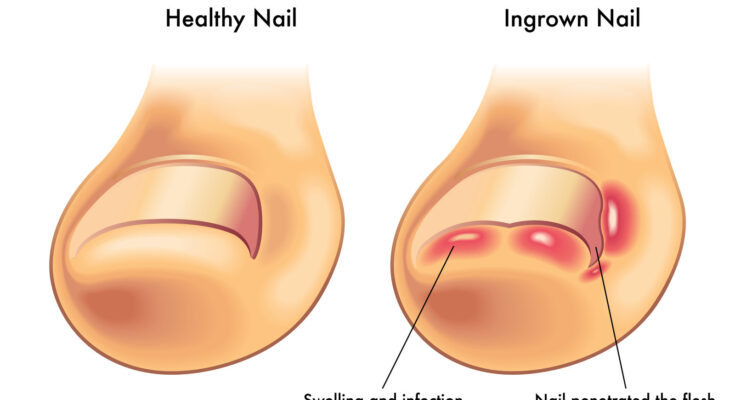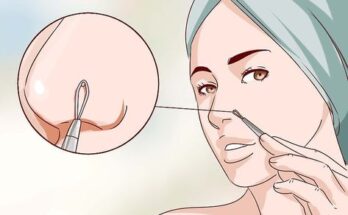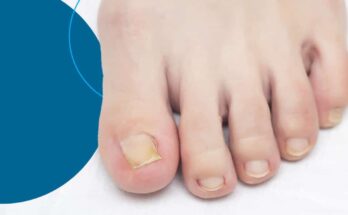An ingrown toenail is a common condition that occurs when the edge of a toenail grows into the surrounding skin, leading to pain, swelling, and sometimes infection. When this condition is accompanied by an inflammatory process, it can lead to further complications such as redness, increased pain, and potential abscess formation. In this article, we will explore the causes, symptoms, treatment options, and preventive measures for ingrown toenails with an inflammatory process, providing a comprehensive guide to understanding and managing this condition.
What is an Ingrown Toenail?
An ingrown toenail, medically known as onychocryptosis, occurs when a corner or side of a toenail grows into the surrounding skin. This condition typically affects the big toe but can occur on any toe. The toenail may become painful, red, swollen, and even infected if not treated properly.
Ingrown toenails are often caused by improper nail trimming, wearing tight or ill-fitting shoes, or trauma to the toe. Over time, the toenail becomes embedded in the skin, and the body responds with an inflammatory process, attempting to heal the damage. This can lead to significant discomfort and, if left untreated, can result in more severe complications.
The Inflammatory Process in Ingrown Toenails
When a toenail becomes ingrown, the body’s natural inflammatory response is triggered. The inflammatory process involves the body sending immune cells to the site of injury to fight infection and promote healing. This can lead to symptoms such as redness, heat, swelling, and pain in the affected area.
The process can become more severe if the ingrown toenail leads to an infection. Bacteria can enter the skin where the nail has pierced, leading to further inflammation. Common signs of infection include:
- Increased redness
- Pus drainage
- Increased swelling
- Throbbing pain
- Fever (in more severe cases)
If the infection is not addressed, it can spread to surrounding tissues or even the bone, leading to serious complications.
Causes of Ingrown Toenail with Inflammatory Process
Several factors contribute to the development of an ingrown toenail and the inflammatory process that accompanies it. Understanding these causes can help in preventing and managing the condition effectively.
1. Improper Nail Cutting
One of the most common causes of ingrown toenails is improper nail trimming. Cutting the toenails too short or rounding the corners of the nails can encourage the nail to grow into the skin. This is especially common when people attempt to cut their nails in a way that leaves them uneven or jagged, which can irritate the skin.
2. Tight or Ill-Fitting Shoes
Wearing shoes that are too tight or narrow can place pressure on the toes, causing the toenails to grow into the skin. High-heeled shoes, in particular, can exacerbate the problem, as they force the toes into a cramped position.
3. Trauma or Injury
Injuries to the toenail, such as dropping something heavy on the toe or stubbing the toe, can cause the nail to become ingrown. This is especially true if the injury disrupts the nail’s natural growth pattern, causing it to grow abnormally into the surrounding tissue.
4. Genetics
Some people are genetically predisposed to developing ingrown toenails. This may be due to the natural shape of the toenails or the structure of the toes, which may cause the nails to press against the surrounding skin more easily.
5. Excessive Sweating
Excessive moisture can soften the skin around the toenail, making it more vulnerable to injury. Sweat can create an ideal environment for bacterial growth, contributing to the inflammatory process. Athletes, especially those who wear tight shoes during exercise, are often more prone to developing ingrown toenails.
6. Improper Foot Care
Poor foot hygiene, such as not drying the feet properly after a shower, can lead to fungal or bacterial infections that exacerbate the inflammatory process. Additionally, failure to trim nails properly or regularly can increase the risk of ingrown toenails.
7. Medical Conditions
Certain medical conditions such as diabetes, vascular disease, or obesity can increase the risk of developing ingrown toenails. These conditions may reduce circulation to the feet or affect the body’s ability to heal, making an ingrown toenail more likely to become infected and inflamed.
Symptoms of Ingrown Toenail with Inflammatory Process
When an ingrown toenail develops an inflammatory process, the symptoms can be quite distressing. The most common symptoms include:
- Pain – The pain associated with an ingrown toenail can range from mild to severe, depending on the extent of the inflammation and any infection present. Pain is typically felt on the side of the toe where the nail is embedded in the skin.
- Redness and Swelling – The affected area will usually become red and swollen due to inflammation. The surrounding skin may become tender to the touch.
- Pus or Discharge – If the ingrown toenail is infected, pus may begin to drain from the site. This is a sign of bacterial infection and should be treated promptly to avoid further complications.
- Warmth – The inflamed area may feel warm to the touch, another indication of the body’s immune response fighting the infection.
- Fever – In more severe cases, a fever may develop if the infection spreads or worsens.
- Throbbing or Pulsating Sensation – The inflamed tissue may cause a throbbing or pulsing sensation, particularly if the area is infected.
Treatment Options for Ingrown Toenail with Inflammatory Process
Early intervention is key in treating an ingrown toenail with an inflammatory process. The goal of treatment is to reduce pain, control inflammation, and prevent or treat infection. Below are common treatment options:
1. At-Home Care for Mild Cases
In the early stages, many ingrown toenails can be treated at home, especially if the condition has not yet progressed to an infection. Here are steps you can take:
- Soak the Toe: Soak the affected toe in warm water for 15–20 minutes several times a day. This can help reduce swelling and soften the skin, making it easier to manage the nail.
- Use Over-the-Counter Pain Relievers: Non-steroidal anti-inflammatory drugs (NSAIDs), such as ibuprofen or acetaminophen, can help reduce pain and inflammation.
- Proper Foot Hygiene: Keeping the area clean and dry is essential. Gently wash the toe with mild soap and water, and then dry it thoroughly before covering it with a clean bandage.
- Cotton or Dental Floss: Some people attempt to place a small piece of cotton or dental floss under the edge of the ingrown nail to lift it away from the skin. This should only be done with caution and proper hygiene to avoid further irritation or infection.
2. Antibiotic Treatment
If there is an infection, topical antibiotics such as Neosporin or polysporin can be applied directly to the affected area to prevent the infection from worsening. Oral antibiotics may be prescribed if the infection has spread.
3. Professional Medical Treatment
If the ingrown toenail becomes severe or infected, it may require professional treatment:
- Partial Nail Removal: In some cases, a podiatrist may need to remove the affected portion of the toenail. This procedure is usually done under local anesthesia.
- Full Nail Removal: In more chronic or severe cases, the entire nail may need to be removed, particularly if the ingrown toenail is recurring or has caused significant damage to the surrounding tissue.
- Matrixectomy: If the ingrown toenail is recurrent, a podiatrist may perform a matrixectomy, where the matrix (the tissue that produces the nail) is destroyed to prevent the toenail from growing back.
4. Surgical Intervention
In rare cases, surgical intervention may be necessary if conservative treatments do not resolve the issue. This involves a more invasive procedure to remove the nail or part of the nail permanently.
Prevention of Ingrown Toenail with Inflammatory Process
While it may not be possible to completely eliminate the risk of ingrown toenails, there are several preventive measures you can take to minimize the chances of developing this painful condition:
- Proper Nail Care: Trim toenails straight across and avoid cutting them too short. Do not round the corners, as this can lead to ingrown nails.
- Wear Comfortable Footwear: Choose shoes that fit properly and have enough room for your toes to move comfortably. Avoid tight shoes or high heels that can put pressure on your toes.
- Maintain Foot Hygiene: Keep your feet clean and dry, especially if you tend to sweat a lot. Fungal infections can complicate ingrown toenails, so it’s important to wash and dry your feet thoroughly each day.
- Protect Your Feet from Injury: Be cautious when engaging in activities that might result in injury to your toes, such as dropping heavy objects or stubbing your toes.
- Use Foot Powder: If your feet tend to sweat a lot, consider using foot powder to keep the area dry and reduce the risk of bacterial or fungal infections.



